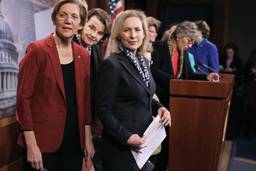What’s going on with the Republicans and sex?
This month, during a flurry of activity at the end of its legislative session, the Wisconsin State Assembly passed a bill that repealed the state’s standards for sex education. The legislature had approved those standards, called the Healthy Youth Act, just two years ago.
With the Act’s passage, Wisconsin became one of just 18 states requiring that sex education classes include information about contraception. If Governor Scott Walker signs the bill that passed two weeks ago, as expected, contraception education will become optional. Abstinence education will still be mandatory.
Several big stories involving sex and reproductive rights have blanketed headlines already this year, so a victory for abstinence education seems to pale by comparison. But Wisconsin’s repeal of the Healthy Youth Act is important because it captures some of the deeper motivations and mechanics behind the broader battles over sex and reproductive rights. The Guttmacher Institute reported recently (PDF) that states passed 92 provisions restricting abortion in 2011—a new record, nearly tripling the old record of 34. And the GOP’s stance on contraceptive coverage in insurance policies has been a central issue in the presidential primaries for several weeks.
Pundits and fundraisers have called these battles the GOP’s “War on Women,” but that formulation has never made much sense. It’s true that the recent anti-choice and anti-contraception legislation has been conceived and approved mostly by men. But it’s also true that those bills have the support of millions of women who enthusiastically endorse the goals of the legislation. Those women are at war, maybe, but not with themselves.
What’s happening can’t be captured in a simple slogan. The “War on Women” is an ideological struggle over the nature of truth and the common good, and it’s a political struggle over the direction of the GOP. Three crucial factors are at work, each building on and reinforcing the other.
Faith is all we need
What’s remarkable about Wisconsin’s repeal of the Healthy Youth Act is the way legislators simply ignored actual evidence and passed the new law based on faith and wishful thinking.
Last year, two researchers at the University of Georgia released the results of a study that focused on the effectiveness of different approaches to sex education. The states with the lowest rates of teen pregnancy required that both abstinence and contraception be taught. States offering abstinence-only education had significantly higher rates of teen pregnancy. The study adds to an already large body of scholarly evidence supporting that conclusion that “prescribed abstinence-only education does not lead to abstinent behavior,” according the authors.
As Bevan Baker, Milwaukee’s commissioner of health, pointed out in a newspaper editorial, the struggle over sex education has profound real-world consequences: “Teen mothers are more likely to drop out of high school, remain unmarried and live in poverty for the decade following their pregnancy. Children born to teen mothers are nine times more likely to live in poverty themselves and are more likely to have lower cognitive development, to be incarcerated and to have an unplanned pregnancy. Nearly all teen births in Wisconsin are paid for by Medicaid.”
So abstinence-only education is not only ineffective; it’s costly. It survives for the same reason that creationist and anti-global-warming arguments survive, despite the scientific consensus against them. The debates aren’t really about the origins of humanity or whether the earth is warming. From an empirical standpoint, those debates are settled. The debates are about whether faith-based communities should cede any authority to evidence-based communities. In sex education, at least, the Wisconsin legislature’s answer is no.
The more the merrier
Pro-choice and concerned about climate change, many progressives believe we need to implement policies and laws that will slow the rate of population growth.
Many conservatives not only reject this premise; they view it as evil. There’s a theological basis for their belief: God’s commandment to humans in Genesis to “be fruitful and multiply and fill the earth.” Rick Santorum is now the most prominent spokesman for this religious perspective. But there’s also a secular, economic rationale. Conservatives view population control as part of a broader conspiracy to re-engineer the American economy and gradually introduce socialism.
Embracing lower rates of population growth as a goal would mean accepting the idea that the capitalism imposes steep costs, and that the free market isn’t self-correcting. Embracing the “be fruitful” imperative demands a faith that capitalism, unleashed, will solve all our problems—that we can endlessly expand our footprint and exploit natural resources without any consequences.
So Wisconsin’s GOP legislators passed a bill that will lead to bad sex education because, in truth, that’s exactly what they want. Effective sex education, like broader access to abortion and higher rates of contraceptive use, would lead to lower rates of population growth. Though these issues are often discussed in moral terms, they’re also, at root, about economic and political philosophy.
The tea party: return of the repressed
On the national stage, the tea party’s fortunes have declined since the debt-ceiling debacle last year. GOP leaders have tried to tone down some of the extreme rhetoric coming from far-right-wing Republicans.
It’s an entirely different story at the state level, which is where the tea party is building an enduring legacy. The record number of restrictions on abortion in 2011 was a direct result of tea party candidates’ success in state-level campaigns the previous year. Wisconsin was among the states with an influx of tea party members in its legislature, and passing new sex education standards was one their priorities. They also imposed new restrictions on abortion. Scores of similar victories in state legislatures across the nation have been crucial to keeping tea-party Republicans engaged, and feeling empowered, at a time when they have few concrete victories to show for their efforts at the national level.
It is easy and comforting to believe that this tea-party-driven “war on women” will become a political liability for Republicans in the elections this fall. But that isn’t a given. At least in the short run, it’s just as likely to be a political asset, since it’s popular with key Republican constituencies that tend to vote at rates higher than the general population: evangelicals and the elderly.
Of course, the impending recall election involving Scott Walker, scheduled for May, will begin to answer some of these questions. It will once again test the tea party’s strength, and it will help determine whether Wisconsin will ever return to the progressive tradition that it helped initiate a century ago, or continues down the tea-party path that it has been travelling for the past two years.
Theo Anderson is an In These Times contributing writer. He has a Ph.D. in modern U.S. history from Yale and writes on the intellectual and religious history of conservatism and progressivism in the United States. Follow him on Twitter @Theoanderson7.





